Critical Analysis: Speech Therapy's Role in Aged Care Settings
VerifiedAdded on 2022/11/14
|15
|3489
|346
Report
AI Summary
This report critically analyzes a news article discussing the advantages of integrating speech therapy within aged care facilities to enhance communication abilities among elderly residents. The introduction highlights the increasing proportion of the older population in Australia and the government's efforts to improve their quality of life. The report summarizes the news item, which emphasizes that speech therapy is beneficial for both children and the elderly, addressing speech disorders like dysphagia and aphasia, often associated with conditions such as Parkinson's and dementia. The discussion section supports the news article's recommendations with evidence from research studies. These studies highlight the effectiveness of speech therapy and vocational therapy in improving cognitive function, speech perception, and overall quality of life for older adults with various impairments, including hearing loss and swallowing disorders. The author argues that implementing speech therapy in residential care settings would improve access, communication, and quality of life for elderly patients. The report acknowledges the strengths of this approach, such as increased accessibility and reduced costs, while also mentioning potential weaknesses like organizational costs. The literature review reveals a gap, emphasizing the need for further research to refine speech therapy interventions for the elderly. Overall, the report concludes that speech therapy significantly benefits elderly individuals in aged care, leading to enhanced communication, improved cognitive function, and a better quality of life.
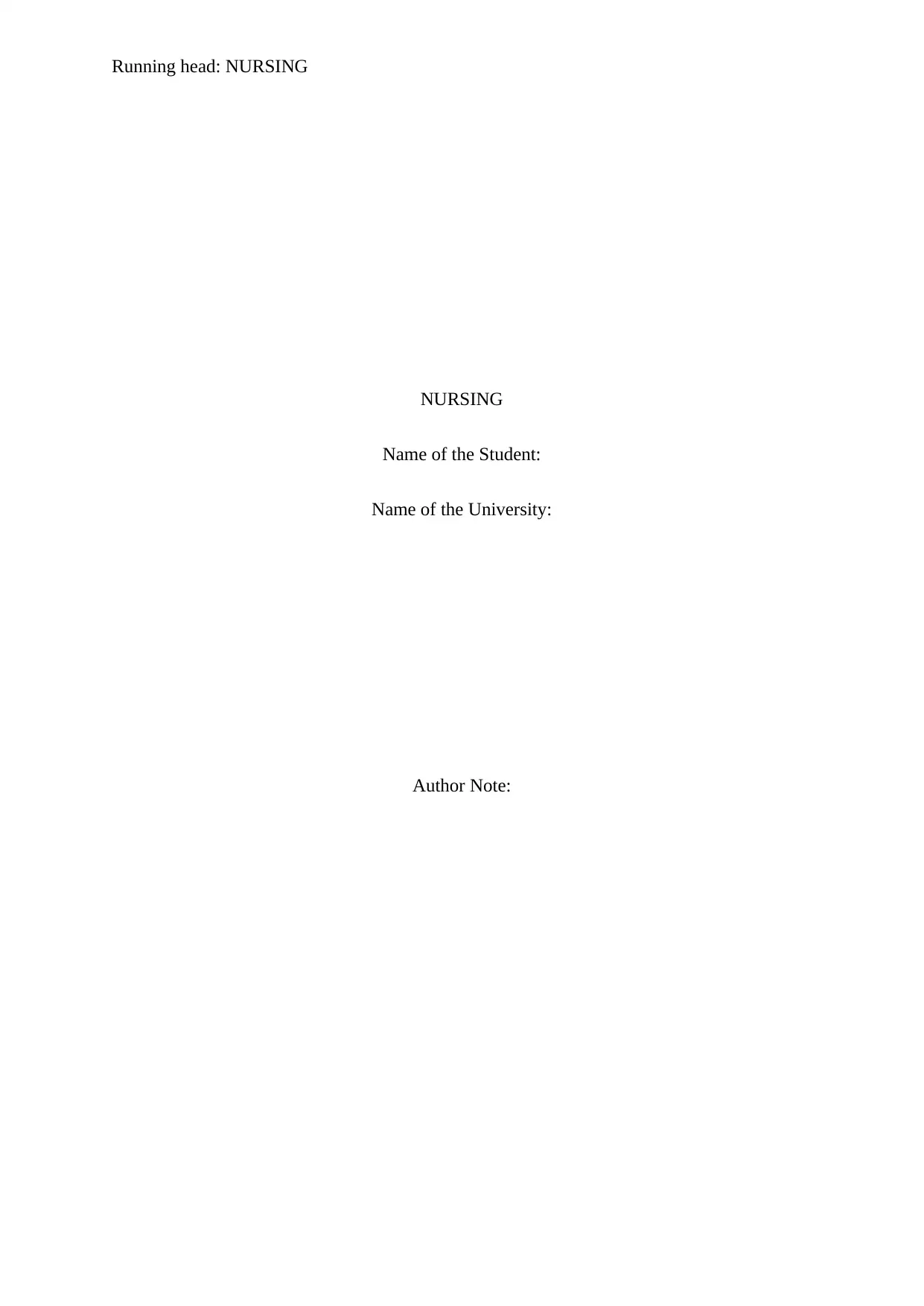
Running head: NURSING
NURSING
Name of the Student:
Name of the University:
Author Note:
NURSING
Name of the Student:
Name of the University:
Author Note:
Paraphrase This Document
Need a fresh take? Get an instant paraphrase of this document with our AI Paraphraser
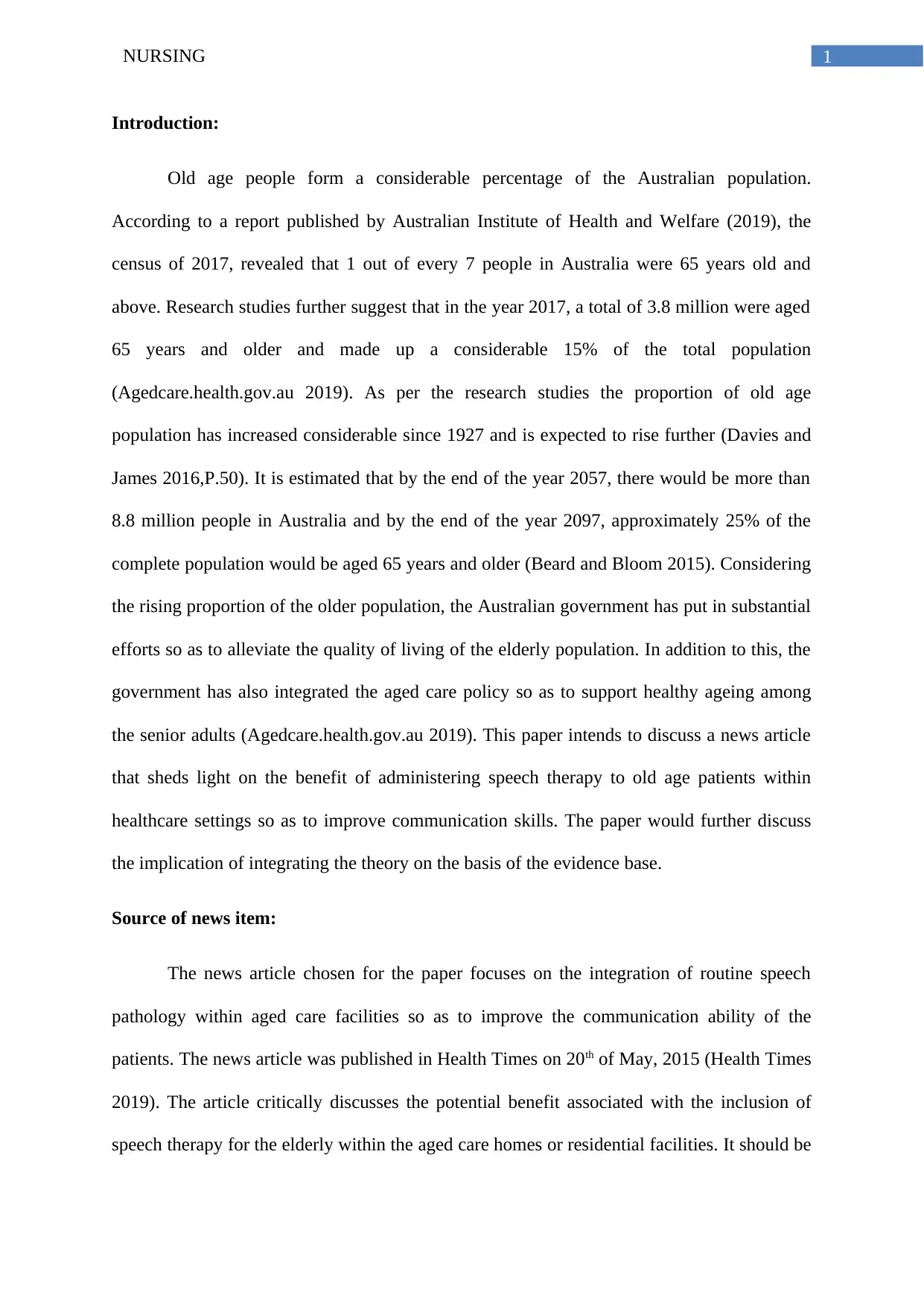
1NURSING
Introduction:
Old age people form a considerable percentage of the Australian population.
According to a report published by Australian Institute of Health and Welfare (2019), the
census of 2017, revealed that 1 out of every 7 people in Australia were 65 years old and
above. Research studies further suggest that in the year 2017, a total of 3.8 million were aged
65 years and older and made up a considerable 15% of the total population
(Agedcare.health.gov.au 2019). As per the research studies the proportion of old age
population has increased considerable since 1927 and is expected to rise further (Davies and
James 2016,P.50). It is estimated that by the end of the year 2057, there would be more than
8.8 million people in Australia and by the end of the year 2097, approximately 25% of the
complete population would be aged 65 years and older (Beard and Bloom 2015). Considering
the rising proportion of the older population, the Australian government has put in substantial
efforts so as to alleviate the quality of living of the elderly population. In addition to this, the
government has also integrated the aged care policy so as to support healthy ageing among
the senior adults (Agedcare.health.gov.au 2019). This paper intends to discuss a news article
that sheds light on the benefit of administering speech therapy to old age patients within
healthcare settings so as to improve communication skills. The paper would further discuss
the implication of integrating the theory on the basis of the evidence base.
Source of news item:
The news article chosen for the paper focuses on the integration of routine speech
pathology within aged care facilities so as to improve the communication ability of the
patients. The news article was published in Health Times on 20th of May, 2015 (Health Times
2019). The article critically discusses the potential benefit associated with the inclusion of
speech therapy for the elderly within the aged care homes or residential facilities. It should be
Introduction:
Old age people form a considerable percentage of the Australian population.
According to a report published by Australian Institute of Health and Welfare (2019), the
census of 2017, revealed that 1 out of every 7 people in Australia were 65 years old and
above. Research studies further suggest that in the year 2017, a total of 3.8 million were aged
65 years and older and made up a considerable 15% of the total population
(Agedcare.health.gov.au 2019). As per the research studies the proportion of old age
population has increased considerable since 1927 and is expected to rise further (Davies and
James 2016,P.50). It is estimated that by the end of the year 2057, there would be more than
8.8 million people in Australia and by the end of the year 2097, approximately 25% of the
complete population would be aged 65 years and older (Beard and Bloom 2015). Considering
the rising proportion of the older population, the Australian government has put in substantial
efforts so as to alleviate the quality of living of the elderly population. In addition to this, the
government has also integrated the aged care policy so as to support healthy ageing among
the senior adults (Agedcare.health.gov.au 2019). This paper intends to discuss a news article
that sheds light on the benefit of administering speech therapy to old age patients within
healthcare settings so as to improve communication skills. The paper would further discuss
the implication of integrating the theory on the basis of the evidence base.
Source of news item:
The news article chosen for the paper focuses on the integration of routine speech
pathology within aged care facilities so as to improve the communication ability of the
patients. The news article was published in Health Times on 20th of May, 2015 (Health Times
2019). The article critically discusses the potential benefit associated with the inclusion of
speech therapy for the elderly within the aged care homes or residential facilities. It should be
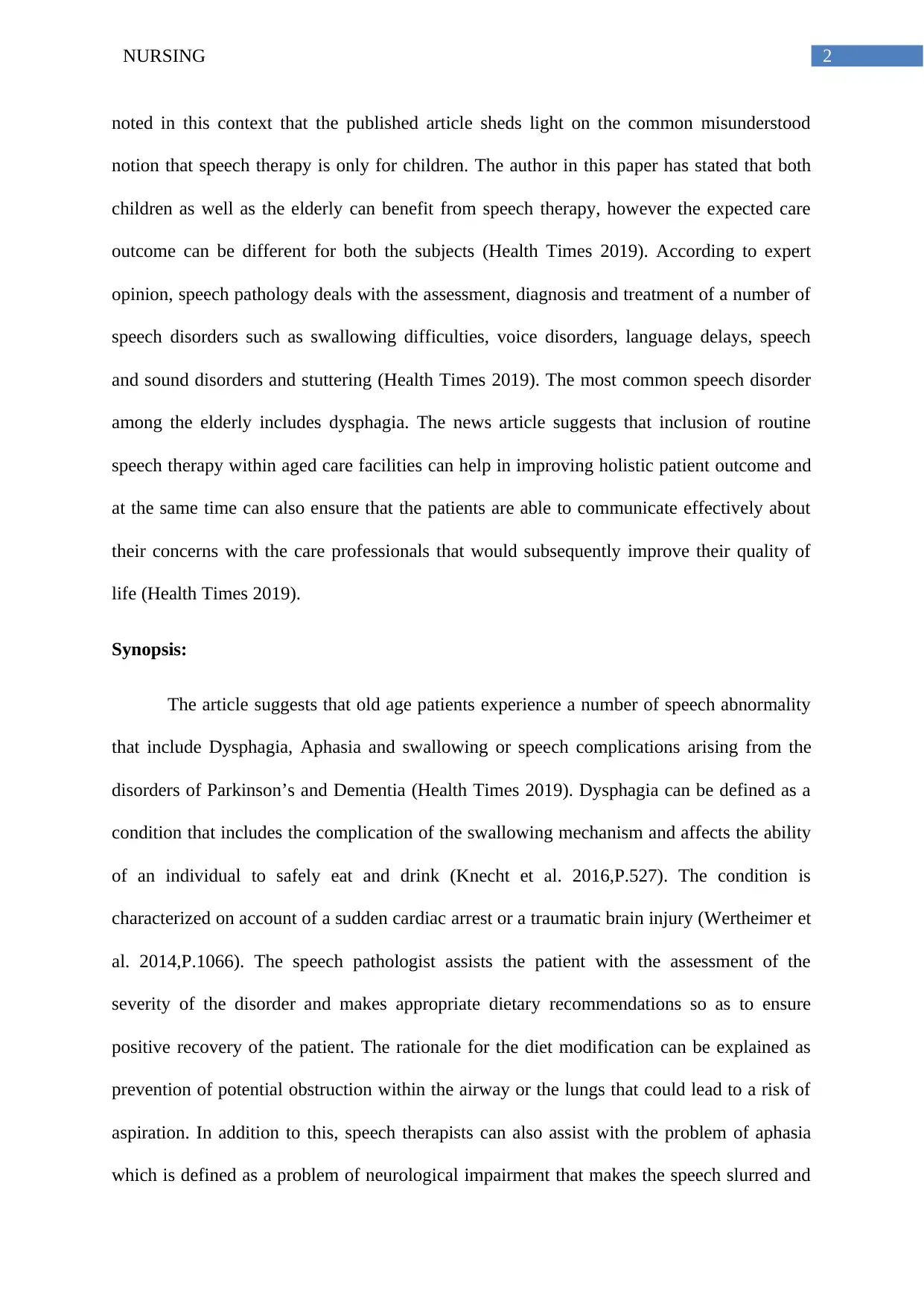
2NURSING
noted in this context that the published article sheds light on the common misunderstood
notion that speech therapy is only for children. The author in this paper has stated that both
children as well as the elderly can benefit from speech therapy, however the expected care
outcome can be different for both the subjects (Health Times 2019). According to expert
opinion, speech pathology deals with the assessment, diagnosis and treatment of a number of
speech disorders such as swallowing difficulties, voice disorders, language delays, speech
and sound disorders and stuttering (Health Times 2019). The most common speech disorder
among the elderly includes dysphagia. The news article suggests that inclusion of routine
speech therapy within aged care facilities can help in improving holistic patient outcome and
at the same time can also ensure that the patients are able to communicate effectively about
their concerns with the care professionals that would subsequently improve their quality of
life (Health Times 2019).
Synopsis:
The article suggests that old age patients experience a number of speech abnormality
that include Dysphagia, Aphasia and swallowing or speech complications arising from the
disorders of Parkinson’s and Dementia (Health Times 2019). Dysphagia can be defined as a
condition that includes the complication of the swallowing mechanism and affects the ability
of an individual to safely eat and drink (Knecht et al. 2016,P.527). The condition is
characterized on account of a sudden cardiac arrest or a traumatic brain injury (Wertheimer et
al. 2014,P.1066). The speech pathologist assists the patient with the assessment of the
severity of the disorder and makes appropriate dietary recommendations so as to ensure
positive recovery of the patient. The rationale for the diet modification can be explained as
prevention of potential obstruction within the airway or the lungs that could lead to a risk of
aspiration. In addition to this, speech therapists can also assist with the problem of aphasia
which is defined as a problem of neurological impairment that makes the speech slurred and
noted in this context that the published article sheds light on the common misunderstood
notion that speech therapy is only for children. The author in this paper has stated that both
children as well as the elderly can benefit from speech therapy, however the expected care
outcome can be different for both the subjects (Health Times 2019). According to expert
opinion, speech pathology deals with the assessment, diagnosis and treatment of a number of
speech disorders such as swallowing difficulties, voice disorders, language delays, speech
and sound disorders and stuttering (Health Times 2019). The most common speech disorder
among the elderly includes dysphagia. The news article suggests that inclusion of routine
speech therapy within aged care facilities can help in improving holistic patient outcome and
at the same time can also ensure that the patients are able to communicate effectively about
their concerns with the care professionals that would subsequently improve their quality of
life (Health Times 2019).
Synopsis:
The article suggests that old age patients experience a number of speech abnormality
that include Dysphagia, Aphasia and swallowing or speech complications arising from the
disorders of Parkinson’s and Dementia (Health Times 2019). Dysphagia can be defined as a
condition that includes the complication of the swallowing mechanism and affects the ability
of an individual to safely eat and drink (Knecht et al. 2016,P.527). The condition is
characterized on account of a sudden cardiac arrest or a traumatic brain injury (Wertheimer et
al. 2014,P.1066). The speech pathologist assists the patient with the assessment of the
severity of the disorder and makes appropriate dietary recommendations so as to ensure
positive recovery of the patient. The rationale for the diet modification can be explained as
prevention of potential obstruction within the airway or the lungs that could lead to a risk of
aspiration. In addition to this, speech therapists can also assist with the problem of aphasia
which is defined as a problem of neurological impairment that makes the speech slurred and
⊘ This is a preview!⊘
Do you want full access?
Subscribe today to unlock all pages.

Trusted by 1+ million students worldwide
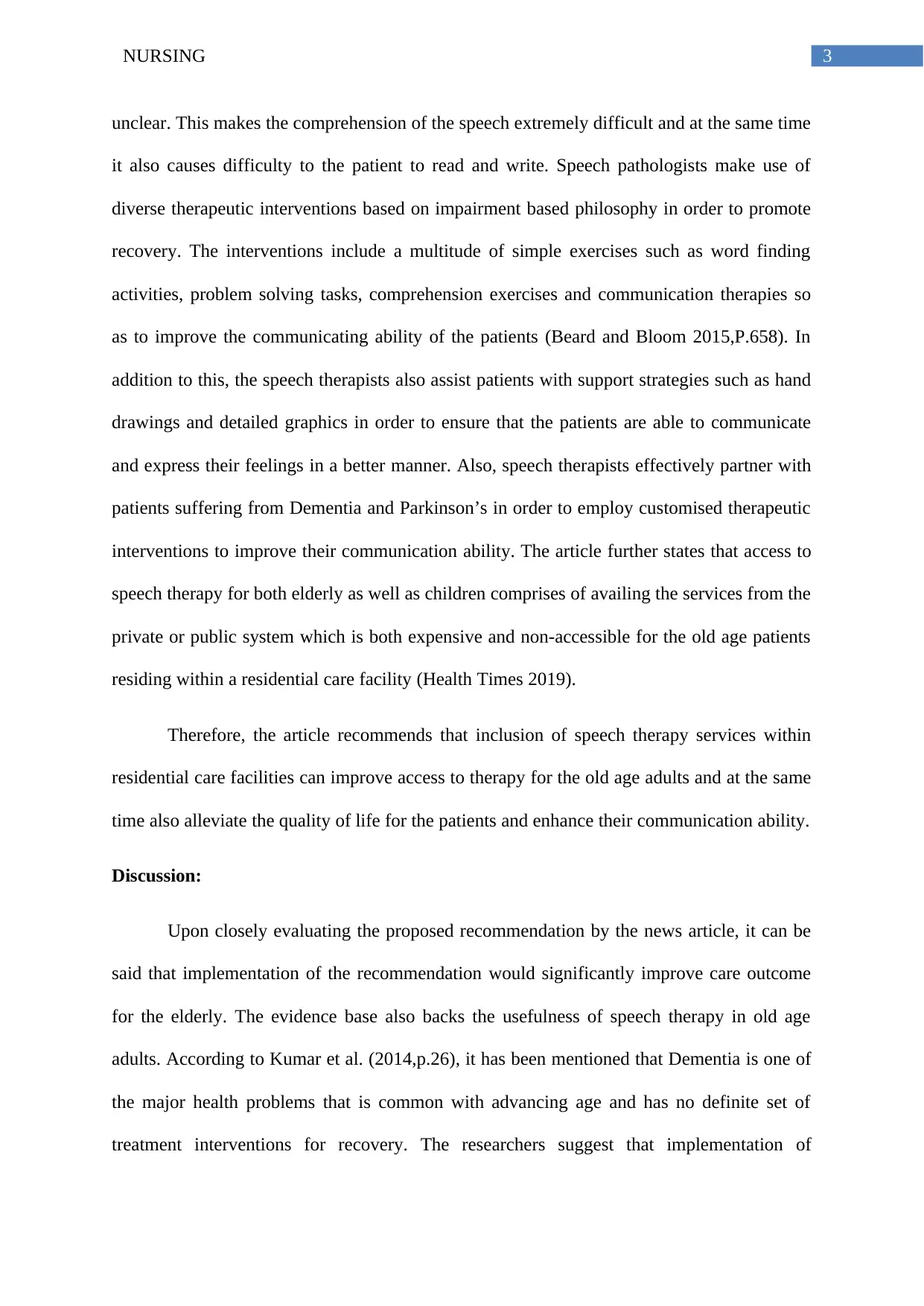
3NURSING
unclear. This makes the comprehension of the speech extremely difficult and at the same time
it also causes difficulty to the patient to read and write. Speech pathologists make use of
diverse therapeutic interventions based on impairment based philosophy in order to promote
recovery. The interventions include a multitude of simple exercises such as word finding
activities, problem solving tasks, comprehension exercises and communication therapies so
as to improve the communicating ability of the patients (Beard and Bloom 2015,P.658). In
addition to this, the speech therapists also assist patients with support strategies such as hand
drawings and detailed graphics in order to ensure that the patients are able to communicate
and express their feelings in a better manner. Also, speech therapists effectively partner with
patients suffering from Dementia and Parkinson’s in order to employ customised therapeutic
interventions to improve their communication ability. The article further states that access to
speech therapy for both elderly as well as children comprises of availing the services from the
private or public system which is both expensive and non-accessible for the old age patients
residing within a residential care facility (Health Times 2019).
Therefore, the article recommends that inclusion of speech therapy services within
residential care facilities can improve access to therapy for the old age adults and at the same
time also alleviate the quality of life for the patients and enhance their communication ability.
Discussion:
Upon closely evaluating the proposed recommendation by the news article, it can be
said that implementation of the recommendation would significantly improve care outcome
for the elderly. The evidence base also backs the usefulness of speech therapy in old age
adults. According to Kumar et al. (2014,p.26), it has been mentioned that Dementia is one of
the major health problems that is common with advancing age and has no definite set of
treatment interventions for recovery. The researchers suggest that implementation of
unclear. This makes the comprehension of the speech extremely difficult and at the same time
it also causes difficulty to the patient to read and write. Speech pathologists make use of
diverse therapeutic interventions based on impairment based philosophy in order to promote
recovery. The interventions include a multitude of simple exercises such as word finding
activities, problem solving tasks, comprehension exercises and communication therapies so
as to improve the communicating ability of the patients (Beard and Bloom 2015,P.658). In
addition to this, the speech therapists also assist patients with support strategies such as hand
drawings and detailed graphics in order to ensure that the patients are able to communicate
and express their feelings in a better manner. Also, speech therapists effectively partner with
patients suffering from Dementia and Parkinson’s in order to employ customised therapeutic
interventions to improve their communication ability. The article further states that access to
speech therapy for both elderly as well as children comprises of availing the services from the
private or public system which is both expensive and non-accessible for the old age patients
residing within a residential care facility (Health Times 2019).
Therefore, the article recommends that inclusion of speech therapy services within
residential care facilities can improve access to therapy for the old age adults and at the same
time also alleviate the quality of life for the patients and enhance their communication ability.
Discussion:
Upon closely evaluating the proposed recommendation by the news article, it can be
said that implementation of the recommendation would significantly improve care outcome
for the elderly. The evidence base also backs the usefulness of speech therapy in old age
adults. According to Kumar et al. (2014,p.26), it has been mentioned that Dementia is one of
the major health problems that is common with advancing age and has no definite set of
treatment interventions for recovery. The researchers suggest that implementation of
Paraphrase This Document
Need a fresh take? Get an instant paraphrase of this document with our AI Paraphraser
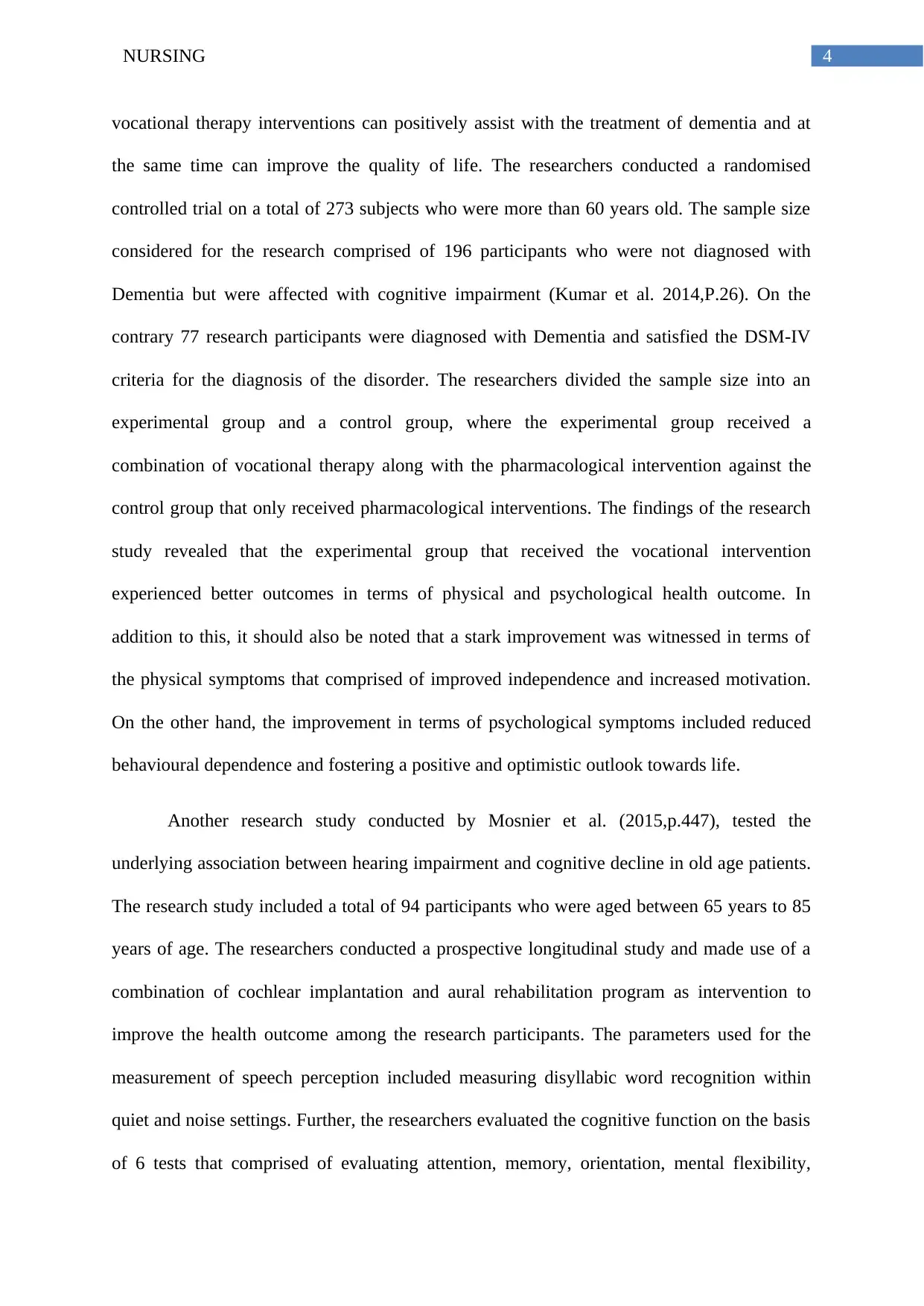
4NURSING
vocational therapy interventions can positively assist with the treatment of dementia and at
the same time can improve the quality of life. The researchers conducted a randomised
controlled trial on a total of 273 subjects who were more than 60 years old. The sample size
considered for the research comprised of 196 participants who were not diagnosed with
Dementia but were affected with cognitive impairment (Kumar et al. 2014,P.26). On the
contrary 77 research participants were diagnosed with Dementia and satisfied the DSM-IV
criteria for the diagnosis of the disorder. The researchers divided the sample size into an
experimental group and a control group, where the experimental group received a
combination of vocational therapy along with the pharmacological intervention against the
control group that only received pharmacological interventions. The findings of the research
study revealed that the experimental group that received the vocational intervention
experienced better outcomes in terms of physical and psychological health outcome. In
addition to this, it should also be noted that a stark improvement was witnessed in terms of
the physical symptoms that comprised of improved independence and increased motivation.
On the other hand, the improvement in terms of psychological symptoms included reduced
behavioural dependence and fostering a positive and optimistic outlook towards life.
Another research study conducted by Mosnier et al. (2015,p.447), tested the
underlying association between hearing impairment and cognitive decline in old age patients.
The research study included a total of 94 participants who were aged between 65 years to 85
years of age. The researchers conducted a prospective longitudinal study and made use of a
combination of cochlear implantation and aural rehabilitation program as intervention to
improve the health outcome among the research participants. The parameters used for the
measurement of speech perception included measuring disyllabic word recognition within
quiet and noise settings. Further, the researchers evaluated the cognitive function on the basis
of 6 tests that comprised of evaluating attention, memory, orientation, mental flexibility,
vocational therapy interventions can positively assist with the treatment of dementia and at
the same time can improve the quality of life. The researchers conducted a randomised
controlled trial on a total of 273 subjects who were more than 60 years old. The sample size
considered for the research comprised of 196 participants who were not diagnosed with
Dementia but were affected with cognitive impairment (Kumar et al. 2014,P.26). On the
contrary 77 research participants were diagnosed with Dementia and satisfied the DSM-IV
criteria for the diagnosis of the disorder. The researchers divided the sample size into an
experimental group and a control group, where the experimental group received a
combination of vocational therapy along with the pharmacological intervention against the
control group that only received pharmacological interventions. The findings of the research
study revealed that the experimental group that received the vocational intervention
experienced better outcomes in terms of physical and psychological health outcome. In
addition to this, it should also be noted that a stark improvement was witnessed in terms of
the physical symptoms that comprised of improved independence and increased motivation.
On the other hand, the improvement in terms of psychological symptoms included reduced
behavioural dependence and fostering a positive and optimistic outlook towards life.
Another research study conducted by Mosnier et al. (2015,p.447), tested the
underlying association between hearing impairment and cognitive decline in old age patients.
The research study included a total of 94 participants who were aged between 65 years to 85
years of age. The researchers conducted a prospective longitudinal study and made use of a
combination of cochlear implantation and aural rehabilitation program as intervention to
improve the health outcome among the research participants. The parameters used for the
measurement of speech perception included measuring disyllabic word recognition within
quiet and noise settings. Further, the researchers evaluated the cognitive function on the basis
of 6 tests that comprised of evaluating attention, memory, orientation, mental flexibility,
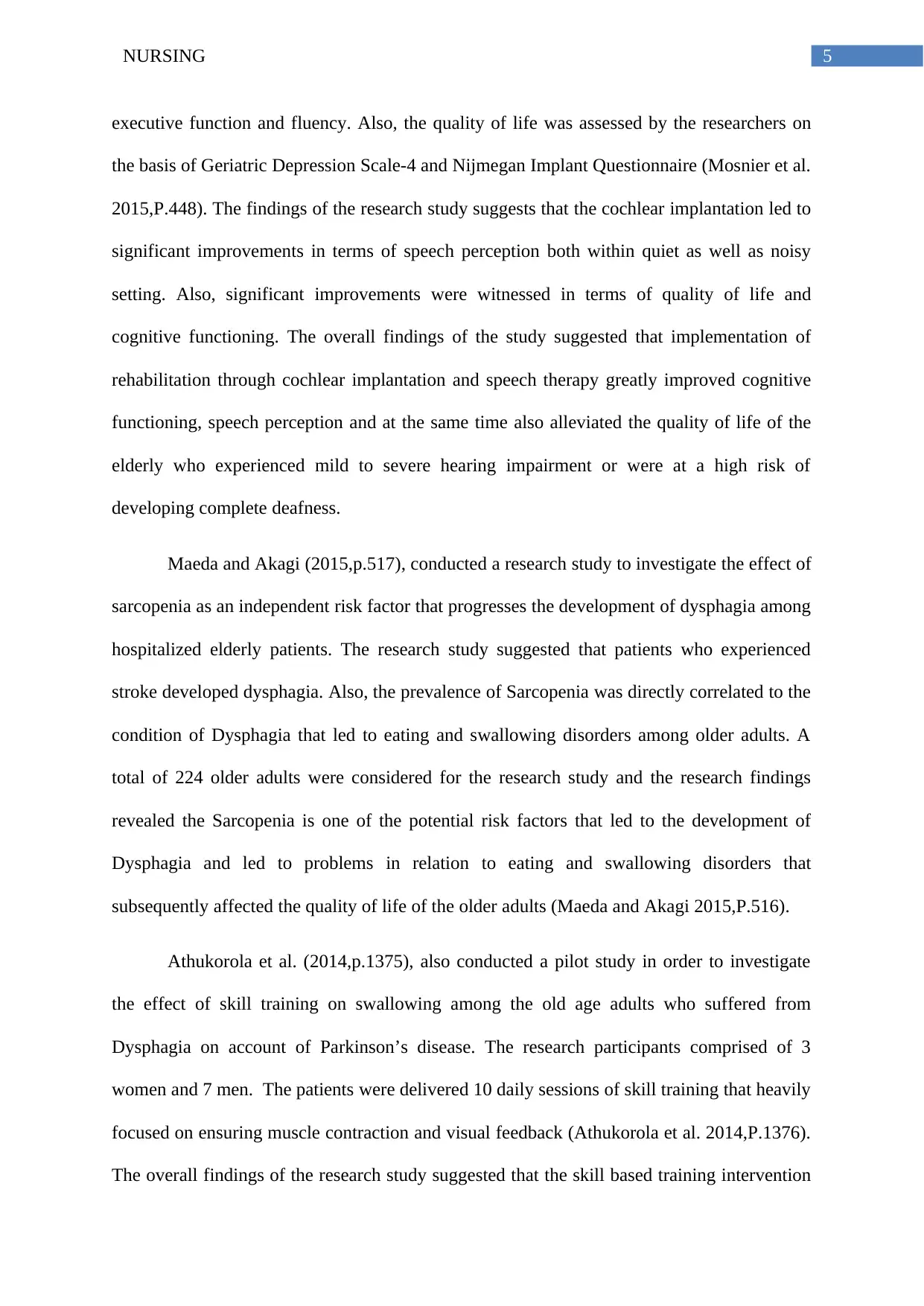
5NURSING
executive function and fluency. Also, the quality of life was assessed by the researchers on
the basis of Geriatric Depression Scale-4 and Nijmegan Implant Questionnaire (Mosnier et al.
2015,P.448). The findings of the research study suggests that the cochlear implantation led to
significant improvements in terms of speech perception both within quiet as well as noisy
setting. Also, significant improvements were witnessed in terms of quality of life and
cognitive functioning. The overall findings of the study suggested that implementation of
rehabilitation through cochlear implantation and speech therapy greatly improved cognitive
functioning, speech perception and at the same time also alleviated the quality of life of the
elderly who experienced mild to severe hearing impairment or were at a high risk of
developing complete deafness.
Maeda and Akagi (2015,p.517), conducted a research study to investigate the effect of
sarcopenia as an independent risk factor that progresses the development of dysphagia among
hospitalized elderly patients. The research study suggested that patients who experienced
stroke developed dysphagia. Also, the prevalence of Sarcopenia was directly correlated to the
condition of Dysphagia that led to eating and swallowing disorders among older adults. A
total of 224 older adults were considered for the research study and the research findings
revealed the Sarcopenia is one of the potential risk factors that led to the development of
Dysphagia and led to problems in relation to eating and swallowing disorders that
subsequently affected the quality of life of the older adults (Maeda and Akagi 2015,P.516).
Athukorola et al. (2014,p.1375), also conducted a pilot study in order to investigate
the effect of skill training on swallowing among the old age adults who suffered from
Dysphagia on account of Parkinson’s disease. The research participants comprised of 3
women and 7 men. The patients were delivered 10 daily sessions of skill training that heavily
focused on ensuring muscle contraction and visual feedback (Athukorola et al. 2014,P.1376).
The overall findings of the research study suggested that the skill based training intervention
executive function and fluency. Also, the quality of life was assessed by the researchers on
the basis of Geriatric Depression Scale-4 and Nijmegan Implant Questionnaire (Mosnier et al.
2015,P.448). The findings of the research study suggests that the cochlear implantation led to
significant improvements in terms of speech perception both within quiet as well as noisy
setting. Also, significant improvements were witnessed in terms of quality of life and
cognitive functioning. The overall findings of the study suggested that implementation of
rehabilitation through cochlear implantation and speech therapy greatly improved cognitive
functioning, speech perception and at the same time also alleviated the quality of life of the
elderly who experienced mild to severe hearing impairment or were at a high risk of
developing complete deafness.
Maeda and Akagi (2015,p.517), conducted a research study to investigate the effect of
sarcopenia as an independent risk factor that progresses the development of dysphagia among
hospitalized elderly patients. The research study suggested that patients who experienced
stroke developed dysphagia. Also, the prevalence of Sarcopenia was directly correlated to the
condition of Dysphagia that led to eating and swallowing disorders among older adults. A
total of 224 older adults were considered for the research study and the research findings
revealed the Sarcopenia is one of the potential risk factors that led to the development of
Dysphagia and led to problems in relation to eating and swallowing disorders that
subsequently affected the quality of life of the older adults (Maeda and Akagi 2015,P.516).
Athukorola et al. (2014,p.1375), also conducted a pilot study in order to investigate
the effect of skill training on swallowing among the old age adults who suffered from
Dysphagia on account of Parkinson’s disease. The research participants comprised of 3
women and 7 men. The patients were delivered 10 daily sessions of skill training that heavily
focused on ensuring muscle contraction and visual feedback (Athukorola et al. 2014,P.1376).
The overall findings of the research study suggested that the skill based training intervention
⊘ This is a preview!⊘
Do you want full access?
Subscribe today to unlock all pages.

Trusted by 1+ million students worldwide
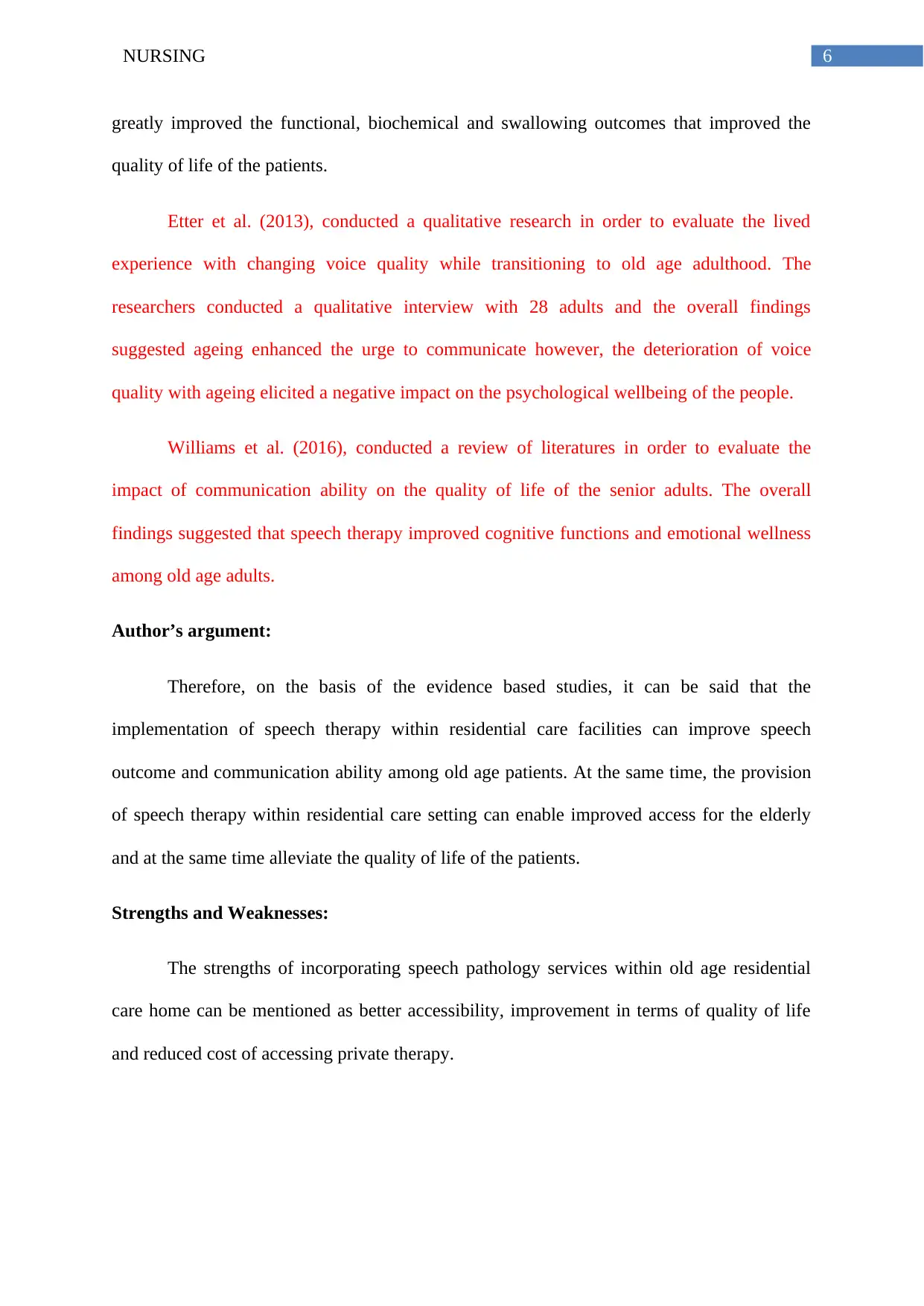
6NURSING
greatly improved the functional, biochemical and swallowing outcomes that improved the
quality of life of the patients.
Etter et al. (2013), conducted a qualitative research in order to evaluate the lived
experience with changing voice quality while transitioning to old age adulthood. The
researchers conducted a qualitative interview with 28 adults and the overall findings
suggested ageing enhanced the urge to communicate however, the deterioration of voice
quality with ageing elicited a negative impact on the psychological wellbeing of the people.
Williams et al. (2016), conducted a review of literatures in order to evaluate the
impact of communication ability on the quality of life of the senior adults. The overall
findings suggested that speech therapy improved cognitive functions and emotional wellness
among old age adults.
Author’s argument:
Therefore, on the basis of the evidence based studies, it can be said that the
implementation of speech therapy within residential care facilities can improve speech
outcome and communication ability among old age patients. At the same time, the provision
of speech therapy within residential care setting can enable improved access for the elderly
and at the same time alleviate the quality of life of the patients.
Strengths and Weaknesses:
The strengths of incorporating speech pathology services within old age residential
care home can be mentioned as better accessibility, improvement in terms of quality of life
and reduced cost of accessing private therapy.
greatly improved the functional, biochemical and swallowing outcomes that improved the
quality of life of the patients.
Etter et al. (2013), conducted a qualitative research in order to evaluate the lived
experience with changing voice quality while transitioning to old age adulthood. The
researchers conducted a qualitative interview with 28 adults and the overall findings
suggested ageing enhanced the urge to communicate however, the deterioration of voice
quality with ageing elicited a negative impact on the psychological wellbeing of the people.
Williams et al. (2016), conducted a review of literatures in order to evaluate the
impact of communication ability on the quality of life of the senior adults. The overall
findings suggested that speech therapy improved cognitive functions and emotional wellness
among old age adults.
Author’s argument:
Therefore, on the basis of the evidence based studies, it can be said that the
implementation of speech therapy within residential care facilities can improve speech
outcome and communication ability among old age patients. At the same time, the provision
of speech therapy within residential care setting can enable improved access for the elderly
and at the same time alleviate the quality of life of the patients.
Strengths and Weaknesses:
The strengths of incorporating speech pathology services within old age residential
care home can be mentioned as better accessibility, improvement in terms of quality of life
and reduced cost of accessing private therapy.
Paraphrase This Document
Need a fresh take? Get an instant paraphrase of this document with our AI Paraphraser
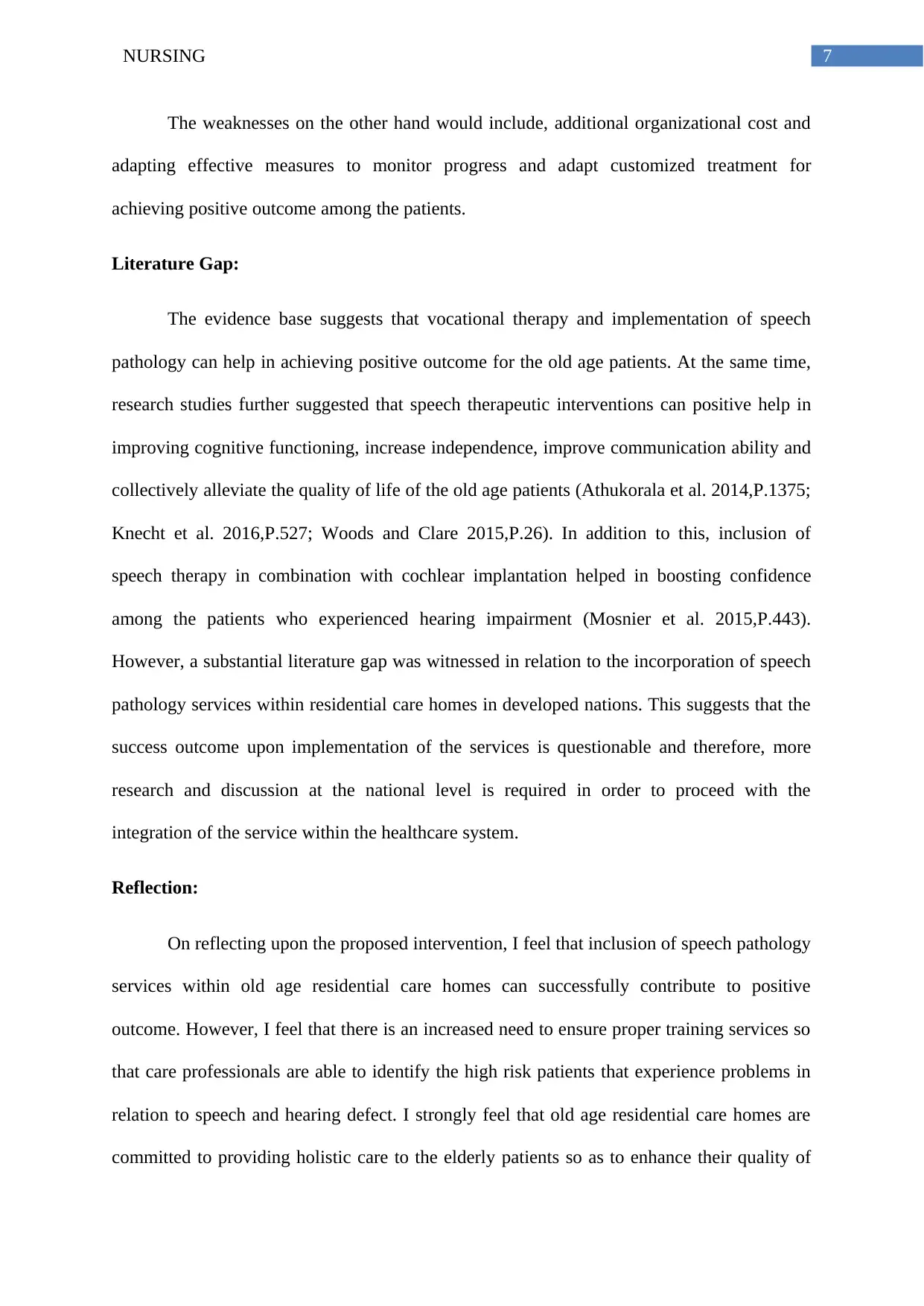
7NURSING
The weaknesses on the other hand would include, additional organizational cost and
adapting effective measures to monitor progress and adapt customized treatment for
achieving positive outcome among the patients.
Literature Gap:
The evidence base suggests that vocational therapy and implementation of speech
pathology can help in achieving positive outcome for the old age patients. At the same time,
research studies further suggested that speech therapeutic interventions can positive help in
improving cognitive functioning, increase independence, improve communication ability and
collectively alleviate the quality of life of the old age patients (Athukorala et al. 2014,P.1375;
Knecht et al. 2016,P.527; Woods and Clare 2015,P.26). In addition to this, inclusion of
speech therapy in combination with cochlear implantation helped in boosting confidence
among the patients who experienced hearing impairment (Mosnier et al. 2015,P.443).
However, a substantial literature gap was witnessed in relation to the incorporation of speech
pathology services within residential care homes in developed nations. This suggests that the
success outcome upon implementation of the services is questionable and therefore, more
research and discussion at the national level is required in order to proceed with the
integration of the service within the healthcare system.
Reflection:
On reflecting upon the proposed intervention, I feel that inclusion of speech pathology
services within old age residential care homes can successfully contribute to positive
outcome. However, I feel that there is an increased need to ensure proper training services so
that care professionals are able to identify the high risk patients that experience problems in
relation to speech and hearing defect. I strongly feel that old age residential care homes are
committed to providing holistic care to the elderly patients so as to enhance their quality of
The weaknesses on the other hand would include, additional organizational cost and
adapting effective measures to monitor progress and adapt customized treatment for
achieving positive outcome among the patients.
Literature Gap:
The evidence base suggests that vocational therapy and implementation of speech
pathology can help in achieving positive outcome for the old age patients. At the same time,
research studies further suggested that speech therapeutic interventions can positive help in
improving cognitive functioning, increase independence, improve communication ability and
collectively alleviate the quality of life of the old age patients (Athukorala et al. 2014,P.1375;
Knecht et al. 2016,P.527; Woods and Clare 2015,P.26). In addition to this, inclusion of
speech therapy in combination with cochlear implantation helped in boosting confidence
among the patients who experienced hearing impairment (Mosnier et al. 2015,P.443).
However, a substantial literature gap was witnessed in relation to the incorporation of speech
pathology services within residential care homes in developed nations. This suggests that the
success outcome upon implementation of the services is questionable and therefore, more
research and discussion at the national level is required in order to proceed with the
integration of the service within the healthcare system.
Reflection:
On reflecting upon the proposed intervention, I feel that inclusion of speech pathology
services within old age residential care homes can successfully contribute to positive
outcome. However, I feel that there is an increased need to ensure proper training services so
that care professionals are able to identify the high risk patients that experience problems in
relation to speech and hearing defect. I strongly feel that old age residential care homes are
committed to providing holistic care to the elderly patients so as to enhance their quality of
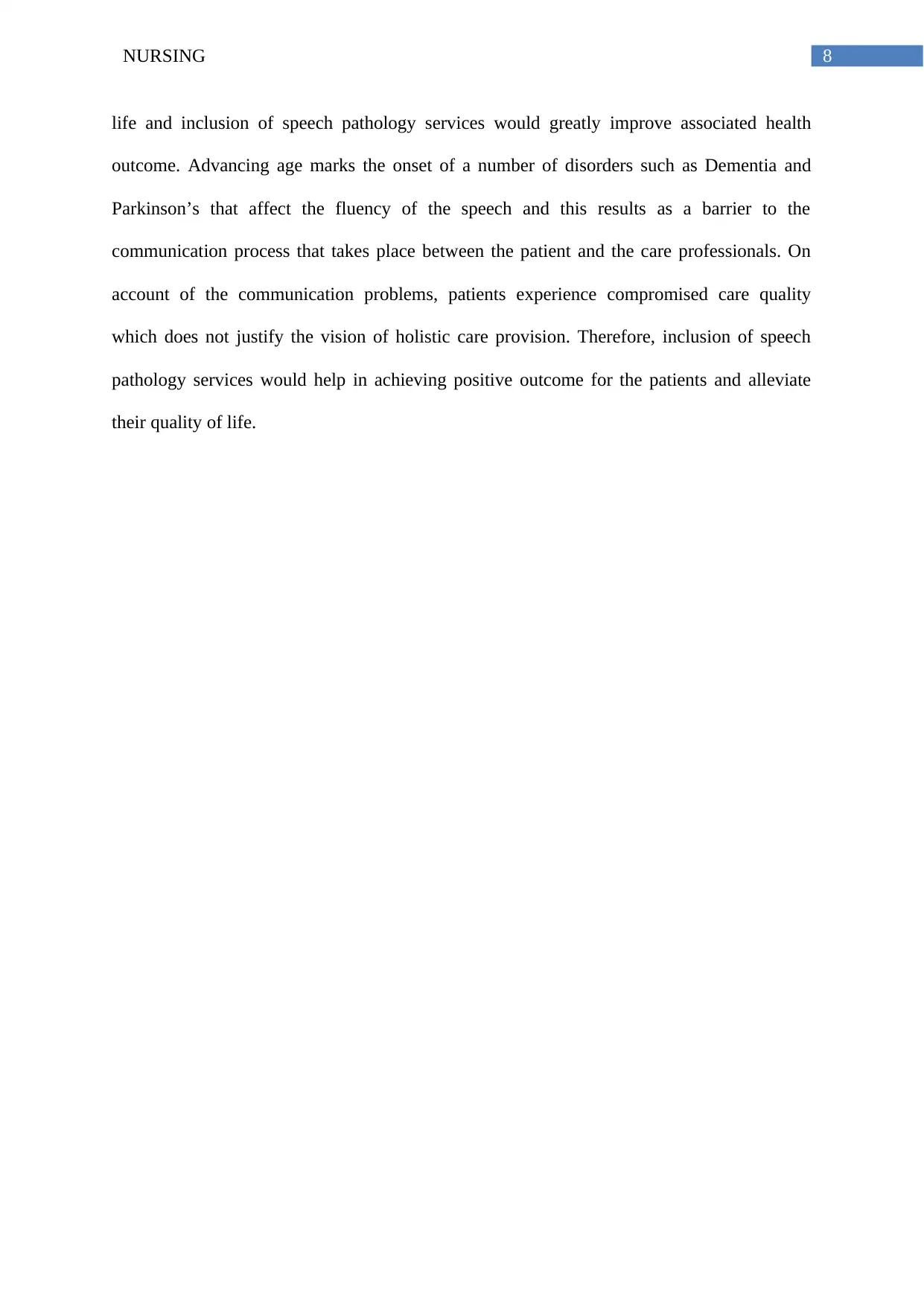
8NURSING
life and inclusion of speech pathology services would greatly improve associated health
outcome. Advancing age marks the onset of a number of disorders such as Dementia and
Parkinson’s that affect the fluency of the speech and this results as a barrier to the
communication process that takes place between the patient and the care professionals. On
account of the communication problems, patients experience compromised care quality
which does not justify the vision of holistic care provision. Therefore, inclusion of speech
pathology services would help in achieving positive outcome for the patients and alleviate
their quality of life.
life and inclusion of speech pathology services would greatly improve associated health
outcome. Advancing age marks the onset of a number of disorders such as Dementia and
Parkinson’s that affect the fluency of the speech and this results as a barrier to the
communication process that takes place between the patient and the care professionals. On
account of the communication problems, patients experience compromised care quality
which does not justify the vision of holistic care provision. Therefore, inclusion of speech
pathology services would help in achieving positive outcome for the patients and alleviate
their quality of life.
⊘ This is a preview!⊘
Do you want full access?
Subscribe today to unlock all pages.

Trusted by 1+ million students worldwide
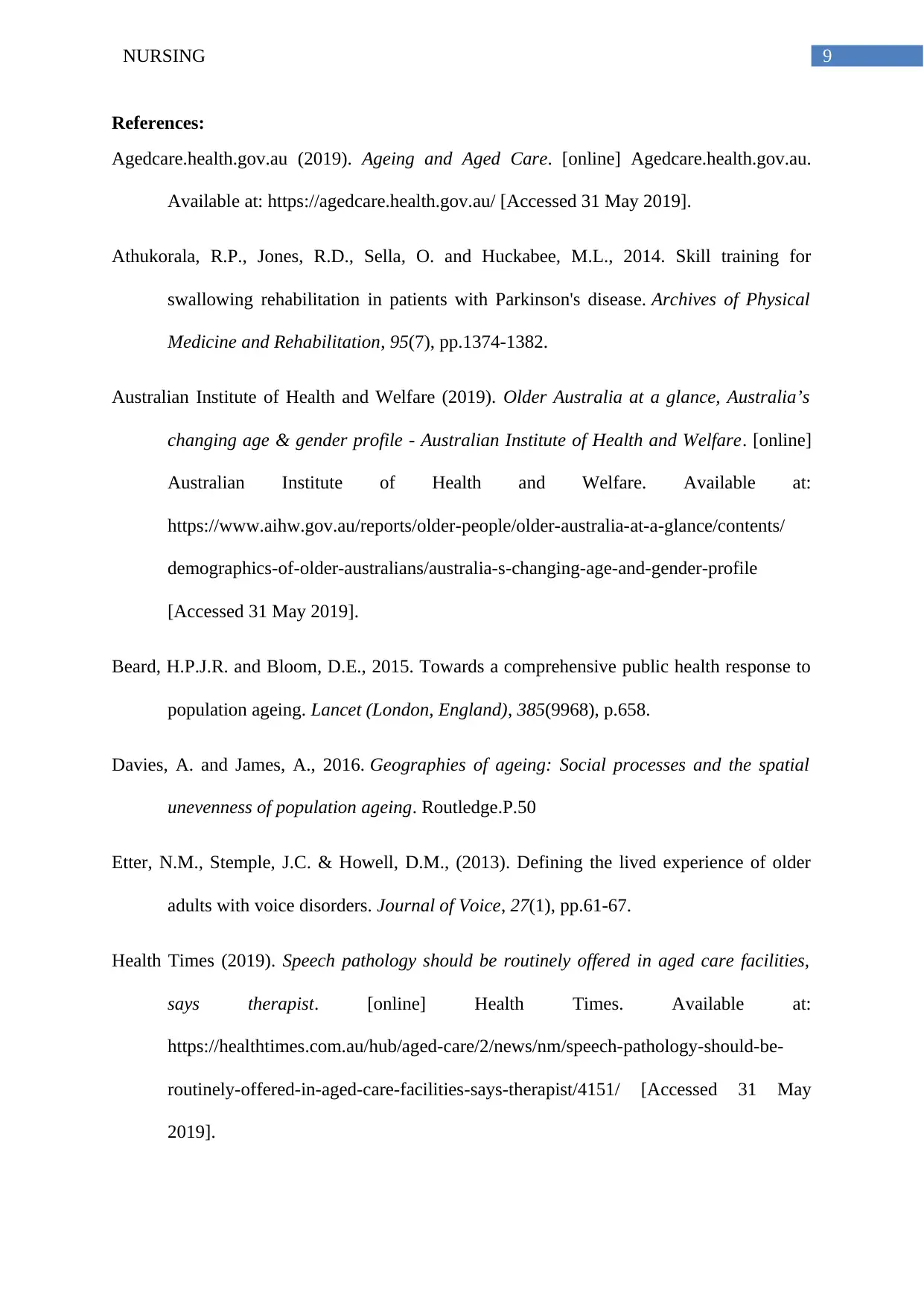
9NURSING
References:
Agedcare.health.gov.au (2019). Ageing and Aged Care. [online] Agedcare.health.gov.au.
Available at: https://agedcare.health.gov.au/ [Accessed 31 May 2019].
Athukorala, R.P., Jones, R.D., Sella, O. and Huckabee, M.L., 2014. Skill training for
swallowing rehabilitation in patients with Parkinson's disease. Archives of Physical
Medicine and Rehabilitation, 95(7), pp.1374-1382.
Australian Institute of Health and Welfare (2019). Older Australia at a glance, Australia’s
changing age & gender profile - Australian Institute of Health and Welfare. [online]
Australian Institute of Health and Welfare. Available at:
https://www.aihw.gov.au/reports/older-people/older-australia-at-a-glance/contents/
demographics-of-older-australians/australia-s-changing-age-and-gender-profile
[Accessed 31 May 2019].
Beard, H.P.J.R. and Bloom, D.E., 2015. Towards a comprehensive public health response to
population ageing. Lancet (London, England), 385(9968), p.658.
Davies, A. and James, A., 2016. Geographies of ageing: Social processes and the spatial
unevenness of population ageing. Routledge.P.50
Etter, N.M., Stemple, J.C. & Howell, D.M., (2013). Defining the lived experience of older
adults with voice disorders. Journal of Voice, 27(1), pp.61-67.
Health Times (2019). Speech pathology should be routinely offered in aged care facilities,
says therapist. [online] Health Times. Available at:
https://healthtimes.com.au/hub/aged-care/2/news/nm/speech-pathology-should-be-
routinely-offered-in-aged-care-facilities-says-therapist/4151/ [Accessed 31 May
2019].
References:
Agedcare.health.gov.au (2019). Ageing and Aged Care. [online] Agedcare.health.gov.au.
Available at: https://agedcare.health.gov.au/ [Accessed 31 May 2019].
Athukorala, R.P., Jones, R.D., Sella, O. and Huckabee, M.L., 2014. Skill training for
swallowing rehabilitation in patients with Parkinson's disease. Archives of Physical
Medicine and Rehabilitation, 95(7), pp.1374-1382.
Australian Institute of Health and Welfare (2019). Older Australia at a glance, Australia’s
changing age & gender profile - Australian Institute of Health and Welfare. [online]
Australian Institute of Health and Welfare. Available at:
https://www.aihw.gov.au/reports/older-people/older-australia-at-a-glance/contents/
demographics-of-older-australians/australia-s-changing-age-and-gender-profile
[Accessed 31 May 2019].
Beard, H.P.J.R. and Bloom, D.E., 2015. Towards a comprehensive public health response to
population ageing. Lancet (London, England), 385(9968), p.658.
Davies, A. and James, A., 2016. Geographies of ageing: Social processes and the spatial
unevenness of population ageing. Routledge.P.50
Etter, N.M., Stemple, J.C. & Howell, D.M., (2013). Defining the lived experience of older
adults with voice disorders. Journal of Voice, 27(1), pp.61-67.
Health Times (2019). Speech pathology should be routinely offered in aged care facilities,
says therapist. [online] Health Times. Available at:
https://healthtimes.com.au/hub/aged-care/2/news/nm/speech-pathology-should-be-
routinely-offered-in-aged-care-facilities-says-therapist/4151/ [Accessed 31 May
2019].
Paraphrase This Document
Need a fresh take? Get an instant paraphrase of this document with our AI Paraphraser
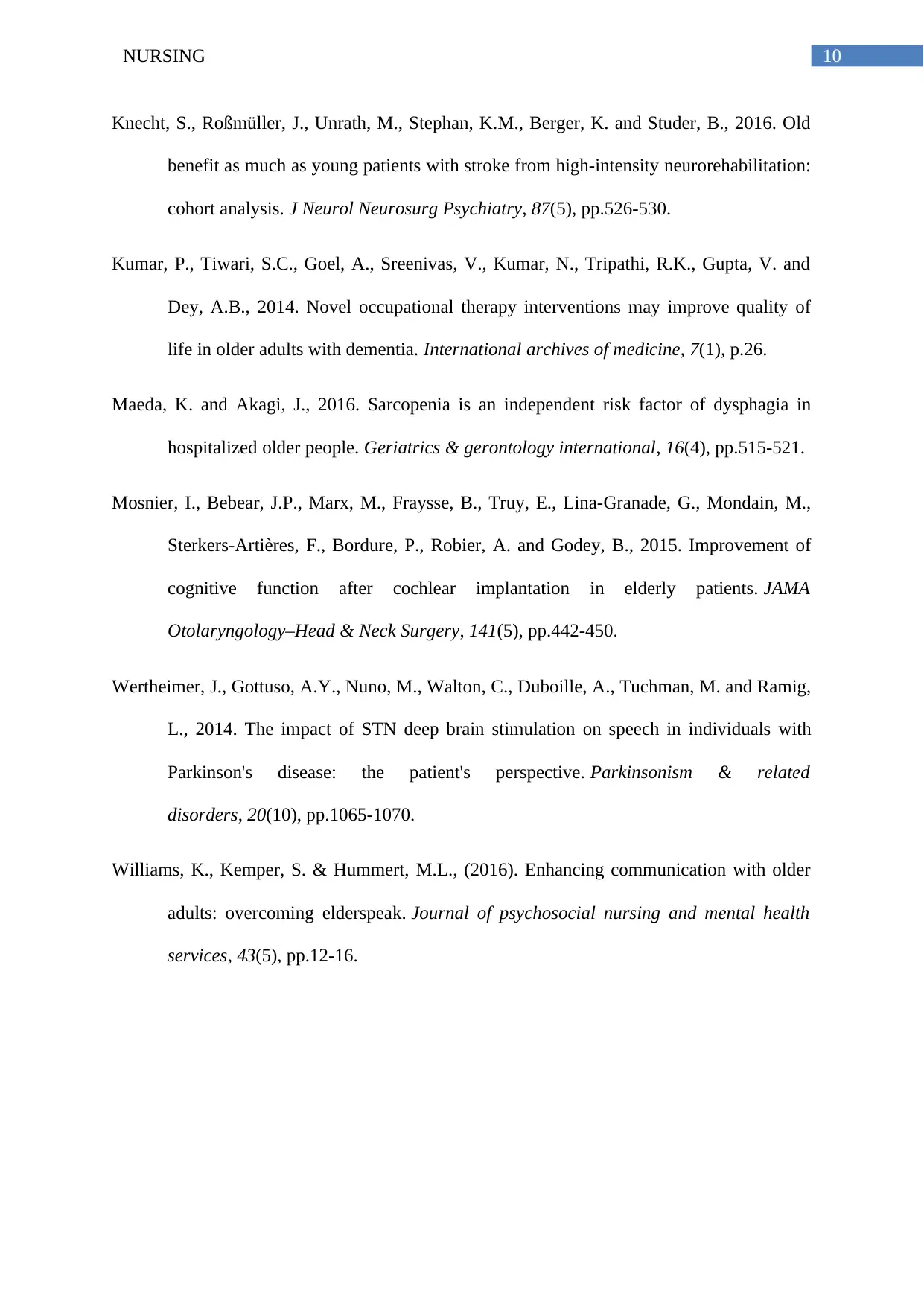
10NURSING
Knecht, S., Roßmüller, J., Unrath, M., Stephan, K.M., Berger, K. and Studer, B., 2016. Old
benefit as much as young patients with stroke from high-intensity neurorehabilitation:
cohort analysis. J Neurol Neurosurg Psychiatry, 87(5), pp.526-530.
Kumar, P., Tiwari, S.C., Goel, A., Sreenivas, V., Kumar, N., Tripathi, R.K., Gupta, V. and
Dey, A.B., 2014. Novel occupational therapy interventions may improve quality of
life in older adults with dementia. International archives of medicine, 7(1), p.26.
Maeda, K. and Akagi, J., 2016. Sarcopenia is an independent risk factor of dysphagia in
hospitalized older people. Geriatrics & gerontology international, 16(4), pp.515-521.
Mosnier, I., Bebear, J.P., Marx, M., Fraysse, B., Truy, E., Lina-Granade, G., Mondain, M.,
Sterkers-Artières, F., Bordure, P., Robier, A. and Godey, B., 2015. Improvement of
cognitive function after cochlear implantation in elderly patients. JAMA
Otolaryngology–Head & Neck Surgery, 141(5), pp.442-450.
Wertheimer, J., Gottuso, A.Y., Nuno, M., Walton, C., Duboille, A., Tuchman, M. and Ramig,
L., 2014. The impact of STN deep brain stimulation on speech in individuals with
Parkinson's disease: the patient's perspective. Parkinsonism & related
disorders, 20(10), pp.1065-1070.
Williams, K., Kemper, S. & Hummert, M.L., (2016). Enhancing communication with older
adults: overcoming elderspeak. Journal of psychosocial nursing and mental health
services, 43(5), pp.12-16.
Knecht, S., Roßmüller, J., Unrath, M., Stephan, K.M., Berger, K. and Studer, B., 2016. Old
benefit as much as young patients with stroke from high-intensity neurorehabilitation:
cohort analysis. J Neurol Neurosurg Psychiatry, 87(5), pp.526-530.
Kumar, P., Tiwari, S.C., Goel, A., Sreenivas, V., Kumar, N., Tripathi, R.K., Gupta, V. and
Dey, A.B., 2014. Novel occupational therapy interventions may improve quality of
life in older adults with dementia. International archives of medicine, 7(1), p.26.
Maeda, K. and Akagi, J., 2016. Sarcopenia is an independent risk factor of dysphagia in
hospitalized older people. Geriatrics & gerontology international, 16(4), pp.515-521.
Mosnier, I., Bebear, J.P., Marx, M., Fraysse, B., Truy, E., Lina-Granade, G., Mondain, M.,
Sterkers-Artières, F., Bordure, P., Robier, A. and Godey, B., 2015. Improvement of
cognitive function after cochlear implantation in elderly patients. JAMA
Otolaryngology–Head & Neck Surgery, 141(5), pp.442-450.
Wertheimer, J., Gottuso, A.Y., Nuno, M., Walton, C., Duboille, A., Tuchman, M. and Ramig,
L., 2014. The impact of STN deep brain stimulation on speech in individuals with
Parkinson's disease: the patient's perspective. Parkinsonism & related
disorders, 20(10), pp.1065-1070.
Williams, K., Kemper, S. & Hummert, M.L., (2016). Enhancing communication with older
adults: overcoming elderspeak. Journal of psychosocial nursing and mental health
services, 43(5), pp.12-16.

11NURSING
Woods, R.T. and Clare, L. eds., 2015. Handbook of the clinical psychology of ageing. John
Wiley & Sons.P.90
Woods, R.T. and Clare, L. eds., 2015. Handbook of the clinical psychology of ageing. John
Wiley & Sons.P.90
⊘ This is a preview!⊘
Do you want full access?
Subscribe today to unlock all pages.

Trusted by 1+ million students worldwide
1 out of 15
Related Documents
Your All-in-One AI-Powered Toolkit for Academic Success.
+13062052269
info@desklib.com
Available 24*7 on WhatsApp / Email
![[object Object]](/_next/static/media/star-bottom.7253800d.svg)
Unlock your academic potential
Copyright © 2020–2025 A2Z Services. All Rights Reserved. Developed and managed by ZUCOL.





